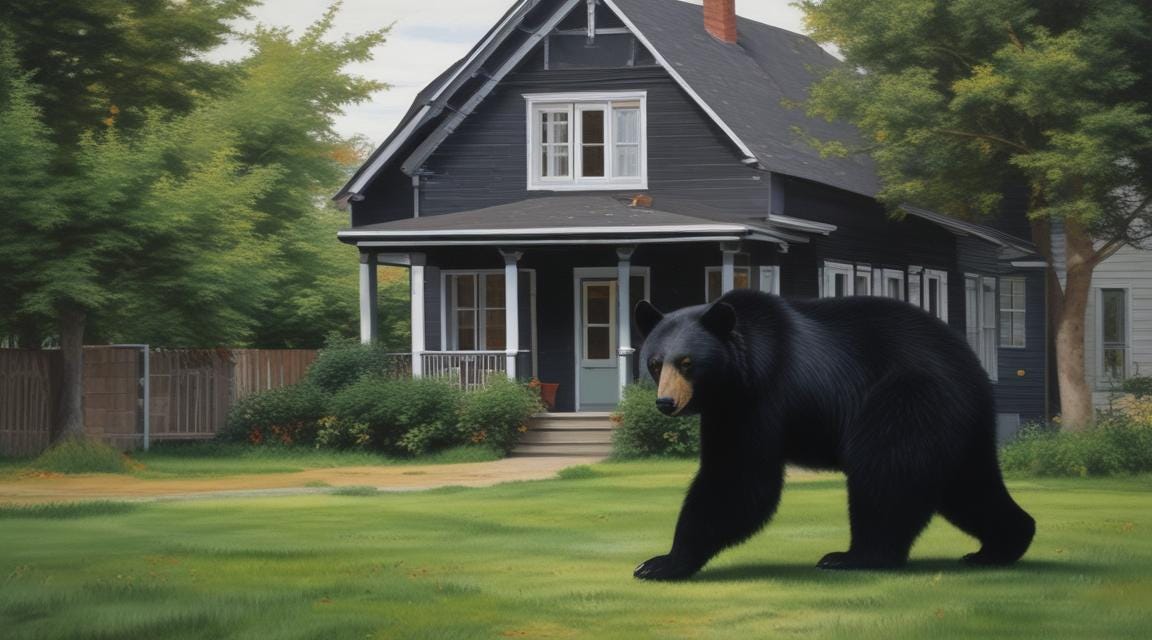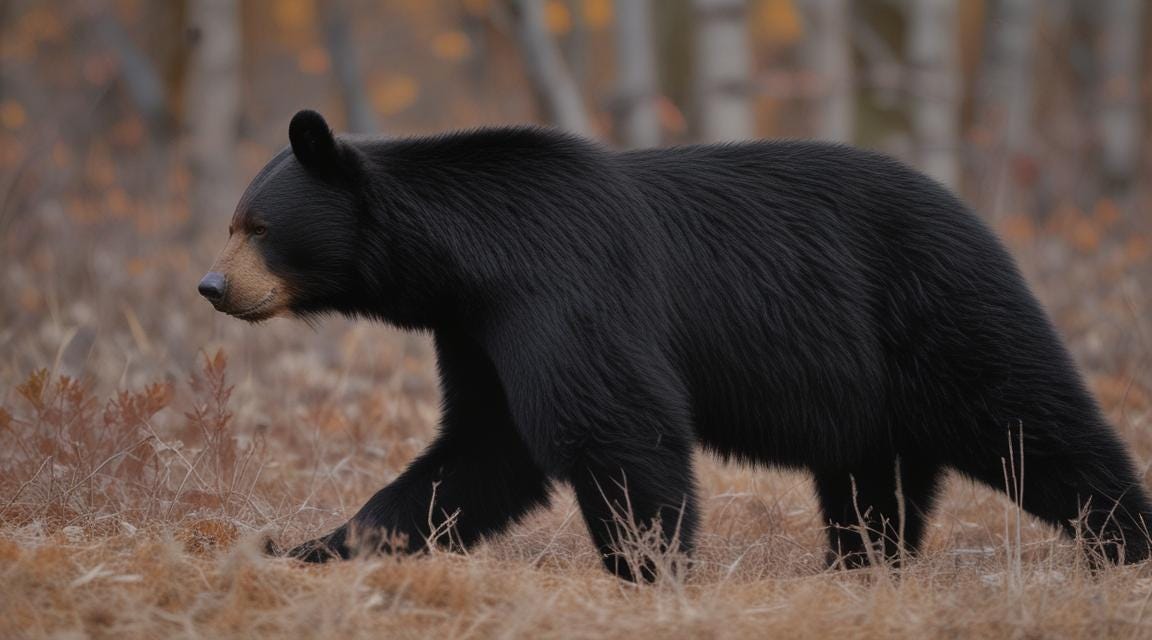It’s been a busy bird season and I’ve seen some possums, skunks, many rabbits, deer, and heard coyotes but I’d been thinking what was missing were bear sightings. And tonight in the evening, an hour or so before dusk, as I was chatting on a neighbor’s porch coming back from taking my old dog for his last walk, along came a large beautiful black bear, no doubt a young one because the oldsters often have ratty patches on their fur.
What a magnificent specimen he was, slowly strolling the sidewalks and walkways in front of the houses, seemingly without a care in the world. He appeared to be investigating, perhaps for bird feeders. At one point I was sure he would find my suet feeder hanging off the deck. Bears love suet and sunflowers seeds. But he stopped and came back along his route, still slowly sashaying along, looking from side to side, this time entering the woods behind some houses. And was gone.
I’ve walked those woods alone but this year, I decided I would stop. Any forays would be with at least one other person because an old woman alone in the deep woods is a fool hardy proposition. I’ve written about this previously. I just love to be in nature, especially in the autumn/fall. The beauty almost takes your breath away but a slip and fall, a twisted ankle, sketchy people, and bear encounters are reasons to think twice when you’re 80.
The black bear population in my area is over 4,500 and expanding eastward. With this come the inevitable occasional encounters and problems with/for/by humans. The problems most often stem from a bear wandering into a yard and finding food in the form of chickens, goats, sheep, bee hives, dirty grills, and bird feeders. In fact, there is no ‘safe’ time of year for bird feeders to be out. I’ve never not put them out because I so love watching bird antics. So, I am part of the problem. Bears have exceptional memories and will continue to come back to the same place for years even when the former food source is gone.
With dwindling natural food sources of berries, grasses, seeds, nuts, honey, insects, fish, carrion and small mammals, black bears normally ‘den’ from about November until March. However, this happens less and less often in males who not only have the pickings from back yards but in towns and small cities with many restaurants and their dumpsters of scraps and uneaten food provide plenty to eat. In my area, it’s more typical for the females and their off spring born that year to ‘den’.
Black bears are not nearly as large as brown bears/grizzlies. Brown bears stand around 7 feet tall and weigh between 400 and 1,000 pounds. Black bears stand about 6 feet tall and weigh ‘only’ 150-600 pounds. I’ve never seen a brown bear in the wild but have seen my share of black bear and they just stop your mind. If it’s in the woods, my hair practically stands on end, especially with a dog who’s small or medium size and a barker. The best course of action is to slowly back away. Never, ever run and don’t even think about climbing a tree. Fortunately, black bear are rarely aggressive toward humans if they are alone and not with cubs. On the other hand, brown/grizzly bears are very aggressive despite what Timothy Treadwell believed and gained notoriety for as he anthropomorphized the bears he loved and spent time with in the Katmai Peninsula of Alaska at the Katmai National Park. And you know might know what happened to him and his girl friend…eaten by one or more grizzlies. The most frightening movie I ever saw was ‘Grizzly Man’, Werner Herzog’s documentary of the life and death of Treadwell. It’s still on at least one of the streaming platforms; if you haven’t seen it just be prepared.
But back to this evening. Here I was sitting on this fellow’s porch talking about, of all things, washers and dryers and bam…there came the bear. It’s so incongruous, this wild thing, huge wild thing, beautiful wild thing treading along past manicured lawns, flower beds, vehicles in driveways. And you wonder, who is out of place? Is it the bear or is it we?
Mary Oliver, as often happens, has the last word.
The Truro Bear
by Mary Oliver
There’s a bear in the Truro woods.
People have seen it - three or four,
or two, or one. I think
of the thickness of the serious woods
around the dark bowls of the Truro ponds;
I think of the blueberry fields, the blackberry tangles,
the cranberry bogs. And the sky
with its new moon, its familiar star-trails,
burns down like a brand-new heaver,
while everywhere I look on the scratchy hillsides
shadows seem to grow shoulders. Surely
a beast might be clever, be lucky, move quietly
through the woods for years, learning to stay away
from roads and houses. Common sense mutters:
it can’t be true, it must be somebody’s
runaway dog. But the seed
has been planted, and when has happiness ever
required much evidence to begin
its leaf-green breathing?




What an entertaining story, Frances! Black bear sightings are common in the forests and nearby cities of the southeastern states. Campgrounds have supposedly bear-proof containers for trash, but lately bears have been getting into them anyway. The guide for my Great Smokies hike in June told us that a reporter interviewing a park ranger had asked why that was happening, and the ranger replied, "The problem is that there is considerable overlap between the smartest bear and the dumbest tourist."
I went for a walk in my favourite woods this morning (in the tame UK) and I think the largest creature I saw on the ground this time was a little wren (do you have wrens where you live Frances?), I have seen deer, and evidence of foxes and badgers, but I cannot imagine what it would be like to meet a non-human creature in these woods BIGGER than me! But it's great to read of your encounter!